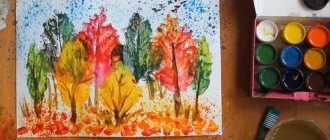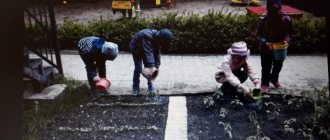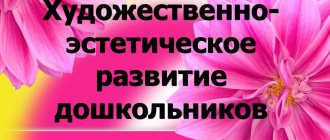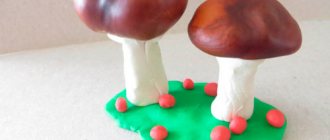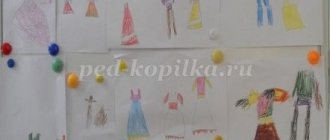Lysenko Ekaterina Yurievna
Summary of the “Golden Autumn” walk with self-analysis (senior group)
Date, brief description of weather conditions
10.10.2018 Air temperature +5 degrees, cloudy, dry.
Theme: Golden autumn
Goal: Creating conditions for preserving and strengthening the health of children.
Tasks:
Enrich and systematize children's knowledge about autumn .
To consolidate knowledge about the dependence of animals on environmental conditions.
Develop cognitive interest.
To consolidate children's knowledge about seasonal changes in nature with the arrival of autumn .
To consolidate children's knowledge about the work of adults in the fall .
Foster a desire to work together, help adults, and finish what you start.
Form an idea of the importance of work for others.
Develop mobility.
Cultivate a love for nature and respect for it.
Equipment and materials: autumn leaves , leaves of birch, maple, rowan, pre-made bird feeders, bird food, an envelope with a letter from Lesovik, a basket with pine cones, children's brooms, buckets, scoops, rakes.
Educational areas: “Physical education”
,
“Cognitive development”
,
“Socio-communicative development”
,
“Speech development”
.
Types of children's activities: communicative, gaming, cognitive-research, motor, labor.
The main forms of work used during walks : observation, didactic games, work in nature, conversation, games of various mobility.
Venue : territory of the preschool educational institution .
Preliminary work: conversation about the signs of autumn , learning poems about autumn , counting rhymes and poems for the game, looking at reproductions of artists “ Autumn ”
.
Progress of the walk
Introductory part
Educator: Guys, come closer to me. I’ll tell you a riddle:
If the leaves on the trees have turned yellow,
If the birds flew to a distant land,
If the sky is gloomy, if it rains,
What is this time of year called? ( autumn )
Educator: Yes, it's autumn . Who will tell a poem about autumn . (children recite familiar poems)
the autumn months in order .
Guys, what signs of autumn do you know?
Sample answers from children: It has become cold, the leaves turn yellow and fall, it rains often, there are frosts in the mornings, the days are getting shorter, the nights are longer, insects and animals are preparing for winter.
Second part
Educator: Yes, autumn is the time of year when all nature changes. The days are getting shorter, the sun is not warming up, it is getting colder day by day, and it rains often. By the end of autumn there will be frosts . Migratory birds fly south, wintering birds move closer to people.
Educator: Guys, what do you think the weather is like today? (gloomy, cloudy, windless)
Why?
(the sun is not visible, the sky is gray, the sky is cloudy, there is no wind)
.
Let's take a breath of autumn air .
Breathing exercise “Smells of nature”
Educator: What smells did you smell? (rotted leaves, spicy grass, mushrooms, smoke)
Frontal observation “What did the trees on the site look like?”
1. Examining trees and shrubs up close and from afar .
2. Children admiring the beauty of trees.
Educator: Guys, look at the multi-colored carpet that covers the ground. What kind of carpet is this? ( Autumn Fallen Leaves )
Let's take the leaves in our hands, what do they feel like?
(dry, rough, rustling)
How do the leaves rustle?
(sh-sh-sh-sh-sh)
Educator: Let's imagine that we are autumn leaves . Let's show how they fall to the ground (children perform voluntary movements)
Low mobility game “ Autumn Leaves”
leaves are quietly spinning ,
The leaves fall quietly under our feet.
And they rustle and rustle underfoot,
As if they want to get dizzy again.
Educator: Yes, in the fall you can often see leaves falling, what is this phenomenon called? (leaf fall)
There were a lot of leaf attacks on our site. Let's see what trees they come from.
Didactic game “Which tree is the leaf from?”
Search tasks.
1. Choose the most beautiful tree for you.
2. Find the reddest (yellow)
tree.
3. Find a leaf that fell today, yesterday, long ago. Tell us how they differ?
Educator: What else grows on our site? ( shrubs )
What is the difference between
a shrub and a tree ? (many thin trunks, low, small leaves, some berries)
Speech exercises.
Game “Say beautiful words about
autumn ” (Goal: be able to select adjectives for a given word)
.
The teacher notices feeders on the veranda.
Educator: What is this, guys? (feeders)
What are they needed for? (for feeding birds)
What can you feed the birds? (seeds, pieces of bread, grains)
Why do some birds fly south with the onset of cold weather? (it became cold, there were no insects, there was little food for birds)
What are these birds called? (migratory)
What are the names of those birds that stay with us for the winter? (wintering)
Educator: Guys, let's turn into birds and play a game.
The third part
Outdoor game: “Migration of birds”
Tasks:
Strengthen the health of players.
Promote their proper physical development.
Promote the acquisition of vital motor skills.
Perform game actions in accordance with the text.
Develop the ability to move in different directions without bumping into each other.
Develop orientation in space.
Cultivate endurance and patience.
Self-analysis of conducting an open walk in the senior group: “Meeting Summer.”
MUNICIPAL BUDGETARY PRESCHOOL EDUCATIONAL INSTITUTION
"NOVOVASYUGANSKY KINDERGARTEN No. 23"
636740, p. New Vasyugan, Geological Lane, 6,
Tomsk region, Kargasoksky district
Phone: (8 38 253) 2-92-50 Fax: (8 38 253) 2-92-50
Self-analysis of conducting an integrated walk using health-saving technologies and experimental activities:
"Meeting Summer"
Senior group.
Educator: Fedyaeva Irina Aleksandrovna.
With. New Vasyugan
2019
Date: November 28, 2019
The theme of the walk: “Meeting summer!” The main direction is the integration of different types of activities using health-saving technologies and experimental activities.
The purpose of the walk: to form in children ideas about the state of air, water, soil, and flora at different times of the year, through play and experimental activities.
A group of 12 senior preschool children took part in the integrated walk. The children of the group have developed skills in cognitive, speech, play and work activities, they know how to hear and listen to the teacher, and easily make contact.
According to the Federal State Educational Standard (FSES), children are educated in preschool educational institutions in five areas: cognitive, physical, artistic, speech and communicative development. These categories are interconnected in the educational process and are implemented throughout the day in kindergarten. Proper organization of walks allows you to achieve the goal of raising a comprehensively developed personality of a child and improving the best qualities in him.
When developing the outline of the walk, first of all, I took into account the age and individual characteristics of the development of children, weather conditions, and based on this, I outlined the goal, objectives, content of the activity, determined the form of conduct, methods, techniques and means necessary to achieve positive results of the activity and compliance with all structural components of the walk.
Tasks:
Educational:
— consolidate knowledge about the change of seasons and their characteristic features;
- expand knowledge about the surrounding world: natural phenomena, animals and
flora;
- promote the formation of thinking skills, namely
independently establish cause-and-effect relationships, analyze, do
conclusions.
- practice the ability to correctly construct sentences;
- improve phrasal speech;
Educational:
- instill an interest in learning about the environment;
- develop observation, curiosity, search skills
research activities, cognitive activity;
- develop motor activity in games in the fresh air;
- develop voluntary attention, visual and auditory perception,
creatively active independent thinking;
— expand active and passive vocabulary;
— promoting artistic and aesthetic development;
- promote the development of creative imagination and fantasy;
- develop fine and gross motor skills;
- develop skills and abilities jointly with the teacher and independently
activities;
Educators:
- cultivate love and respect for nature;
- cultivate a love for the artistic word;
- develop self-confidence, in your strengths and capabilities;
- cultivate a friendly attitude towards peers and surrounding adults,
mutual assistance.
The walk consisted of three interconnected stages, during which the children performed various actions. This structure is completely justified, since each stage is aimed at solving certain problems.
The first, organizational stage, involved organizing children and creating motivation for further activities. This task was realized through a surprise moment - the appearance of the lost Summer on the site. Also, during the organizational stage, children participated in the first part of experimenting with ice and salt, as well as in a conversation about the work of a janitor. During the conversation, the children answered my questions with full answers, constructing short sentences and phrases.
The main part was a specially organized joint activity of children with the teacher and independent activities aimed at solving the assigned tasks of the walk. The implementation of the tasks was ensured by the use of the following methods and techniques during the main stage:
- verbal method, through such techniques as introductory and educational conversation, explanation, instructions, asking questions, saying rhymes and words of an outdoor game, asking riddles, verbal encouragement.
- a visual method, through observation of the teacher’s actions, demonstration of natural phenomena, demonstration of the method of performing actions.
- a practical method through imitative, constructive and creative exercises.
- a gaming method through the sudden appearance of objects, creating a gaming situation.
The purpose of the final stage of the walk was to sum up the entire activity. In my opinion, the methods and techniques I chose when planning the content and conducting this walk were the most effective in achieving the goals. The presence of a fairy-tale character throughout the walk motivated the children to be active. A constant change of activities made it possible to eliminate the occurrence of overwork in children. The use of breathing and finger exercises made it possible to support the direction of health conservation. The children were in a positive mood, showed cognitive, physical and creative activity, and enjoyed the activities I suggested.
I believe that I spent this walk in an emotionally positive environment. The chosen form of organizing a walk in the fresh air was quite effective, logical and dynamic. The goal and objectives of the activity have been achieved.
Observation and analysis of the walk
Assessment of conditions and organization of various activities for children during walks
Age group ________________________
Amount of children ________________________________
| Questions for analysis | Comments |
| Sanitary condition of the site | |
| Remote material | |
| Availability and quantity, marking, etc. | |
| Safety | |
| Suitable for season and age | |
| Organization of a walk | |
| Duration (corresponding to mode) | |
| Individual work with children on the development of basic movements | |
| Outdoor games organized by the teacher (name, number of children participating in the games) | |
| Outdoor games organized by children (name, number of children participating in the games) | |
| Competition games (name, number of children participating in the games) | |
| Independent motor activity of children | |
| Observations in nature | |
| Labor in nature | |
Conclusion:
- Conditions for children's walks in preschool educational institutions
- Availability of structural components of a walk:
-observation of natural objects,
-individual work on the development of basic movements,
- labor processes,
-outdoor games,
-independent activity.
- Efficiency, expediency and variety of techniques for managing various activities of children during a walk, compliance with the season, use of attributes and buildings.
- Taking into account weather conditions, children’s interests and individual characteristics when conducting a walk.
- Techniques for ending a walk, maintaining children’s physical activity in the fresh air
Algorithm for reading and telling literary works
Subject " "
Program content: ______________________________________________
Material:___________________________________________
Organization:
| Parts of the lesson and their goals | Description of interaction with children in direct speech | Possible methodological techniques |
| Preparation for the perception of the text: - organizing new or mobilizing existing experience; — lexical preparation; - stimulating attention and interest in the work | — preliminary conversation; - examining objects, toys, illustrations; — conducting experiments; — display of the author’s portrait; - a story about the author (art. gr.); — explanation of the features of the genre; - explanation of words and expressions; - goal setting | |
| Organization of full perception of the work | - artistic reading (storytelling); — accompanying display of illustrations, game actions (younger group); - listening to an audio recording | |
| Helping children understand the content and artistic means of a work (deepening the perception of the work) | - conversation about what you read; — viewing, discussing illustrations, voicing them; - selective reading at the choice of children and teacher | |
| Consolidating impressions from the listened work and interest in it | - repeated reading of short works; - selective reading of the most striking passages; — listening to an audio recording; - use of dramatization elements; - looking at illustrations; — dubbing illustrations (reproducing characters’ dialogues) |
Methods for developing coherent speech
Analysis of the organization and conduct of didactic games for the development of dialogic speech
Game theme:
| Analysis criteria | Grade | Comments | |
| + | — | ||
| 1Organization and preparation for the game: -psychological attitude - accepting the invitation of children -availability of material | |||
| 2Communication of a game and speech task through a problem, contradiction, speech difficulties in characters and children | |||
| 3Motivation for a goal or task | |||
| 4Game title message | |||
| 5Explanation of the course of the game, conditions with a focus on the result | |||
| 6Indications for the quality of speech utterances, dialogical skills and abilities | |||
| 7Children’s acceptance of the game task, interest | |||
| 8The role of the teacher in the game | |||
| 9Teacher's guide to the game | |||
| 10Children's interest in the game | |||
| 11Following the rules | |||
| 12Violation of the rules | |||
| 13Dynamism of the game | |||
| 14Assessment of children’s dialogical skills | |||
| 15End of the game - reflection | |||
Conclusions:
Offers:
PM.04 Establish how sanitary and educational work is carried out in preschool educational institutions with children (classes, games, holidays...) and parents (instructions, conversations, visual aids) Provide a list of activities carried out by the teacher and medical worker in a specific group. Draw a conclusion about the feasibility of collaboration and the most interesting forms.
| month | event | target |
| September | ||
| October | ||
| November | ||
| December | ||
| January | ||
| February | ||
| March | ||
| April |
Conclusion:____________________________________________________________________________________________________________________________________________________________________________________________________________________________________________________________________________________________________________________________________________________________________________________________________________________________________
PM.04 Establish how musical and educational work with children (classes, games, holidays...) and parents (conversations, visual aids) is carried out in preschool educational institutions. Provide a list of activities carried out by the teacher and music director in a specific group. Draw a conclusion about the feasibility of collaboration and the most interesting forms.
| month | event | target |
| September | ||
| October | ||
| November | ||
| December | ||
| January | ||
| February | ||
| March | ||
| April |
Conclusion:____________________________________________________________________________________________________________________________________________________________________________________________________________________________________________________________________________________________________________________________________________________________________________________________________________________________________
Self-analysis of the final lesson in the 2 ml group
Self-analysis of GCD Titova E. A.
Lesson topic: “Magic feather.”
Integration of educational areas “Speech development”, “Cognitive development”, “Physical development” and “Artistic and aesthetic development”.
Duration 15 min. /corresponding SANPIN requirements.
During the lesson the following tasks were expected to be solved:
Educational:
- expand and activate vocabulary; train in the pronunciation of onomatopoeias;
Educational:
- develop the ability to use accumulated knowledge, visual and auditory attention in a conversation;
Educational:
– cultivate responsiveness, the ability to listen to each other; promote the development of positive emotions.
To successfully solve the identified problems, I prepared the following demonstration material: a feather, pictures of poultry. Handout: ready-made paper blanks for chicken, glue, brush, napkin. He helped me reveal the topic in a bright, interesting and informative way.
To ensure children's interest in the topic and emotional response to it, I used the motivation to find out where the magic feather will lead us.
The lesson consisted of two parts. First: strengthening the understanding of poultry and their chicks; consolidation of the formation of verbs from onomatopoeia (quack-quack - quacks, ku-ka-re-ku - crows, etc.)
;
strengthening the ability to choose words that are opposite in meaning (antonyms)
; encourage children to answer questions; develop children's coherent speech. Second: consolidating children’s understanding of the structural features of birds; Carefully gluing the chicken body parts.
To solve the first problem, I used verbal methods: explanation, reminder, demonstration, questions, visual methods: pictures of poultry. To solve the second problem I used.
Visual methods: pictures of a chicken, ready-made paper blanks for a chicken, glue, brush, napkin.
Throughout the entire lesson, I paid attention to the children’s speech: I sought complete answers, posed searching questions, created conditions for dialogue with the children, etc.
To satisfy the physical activity of the children and maintain their health, I organized physical education, I constantly monitored the seating of the children.
During the lesson, the children were active, remained interested, and were attentive.
To summarize the lesson, I involved the children in this and asked them to speak on the topic: “Who did we meet in the poultry yard?” Was able to create a situation of success.
Throughout the entire NOD, I tried to support children’s cognitive interest with emotional and intonationally expressive speech. When addressing children, I used accessible questions. She took into account the individual capabilities of each child. I believe that the goal I set has been achieved, the tasks have been fully realized.
